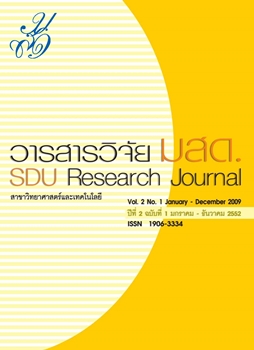การใช้เทคนิค Near Infrared Spectroscopy (NIRS) ในการหาความชื้นและโปรตีนของแป้งสาลี
Keywords:
ความชื้น, เนียร์อินฟราเรดสเปกโตรสโกปี, โปรตีน, แป้งสาลี, moisture content, Near Infrared Spectroscopy, Protein, Wheat FlourAbstract
Abstract
Three types of wheat samples used for this research are all purpose, cake and bread flour. Fifty samples of them were chemically analyzed of which the result showed the amount of protein content and moisture content in the range of 8.19 - 20.91% and 10.09 - 13.68% respectively. The protein and moisture content obtained from the chemical analysis were calibrated for equation by Multiple Linear Regression method (MLR) and Partial Least Square Regression method (PLSR). It is found that the Multiple Linear Regression method is more accurate in predicting the amount of protein content because the Standard Error of Calibration (SEC) and Standard Error of† Prediction (SEP) are quite close, that is, 0.72 and 0.71. Meanwhile, the prediction of moisture content, according to the Partial Least Square Regression (PLSR), the accuracy of prediction comes out at 95.43%, while the Multiple Linear Regression method (MLR) of which the†accuracy is 94.14%. As the result, it may be concluded that the equation calibrated by the Partial Least Square Regression method (PLSR) is, of course, more appropriate to implement for the prediction of the moisture content in wheat flour.
Keyword : moisture content, Near Infrared Spectroscopy, Protein, Wheat Flour








